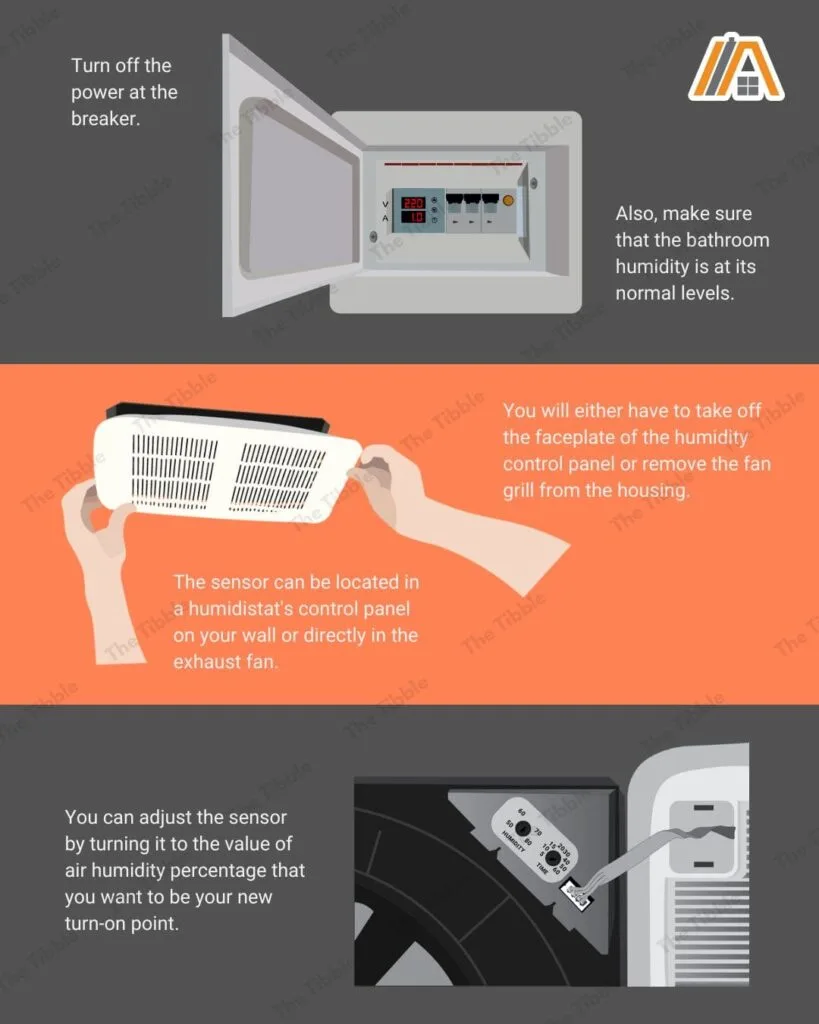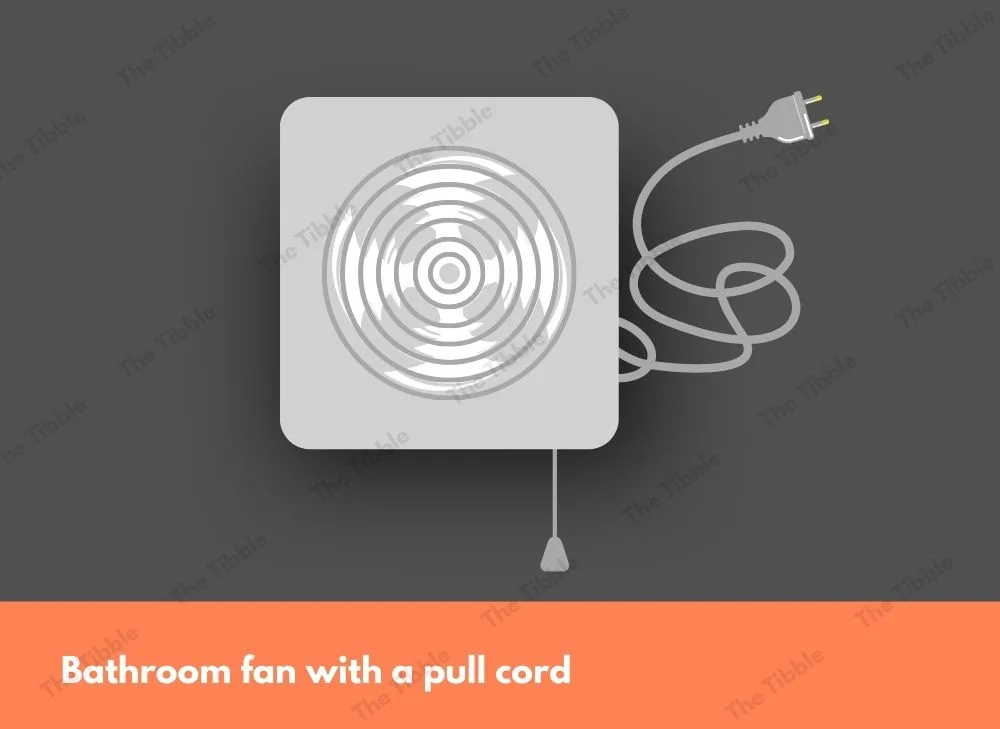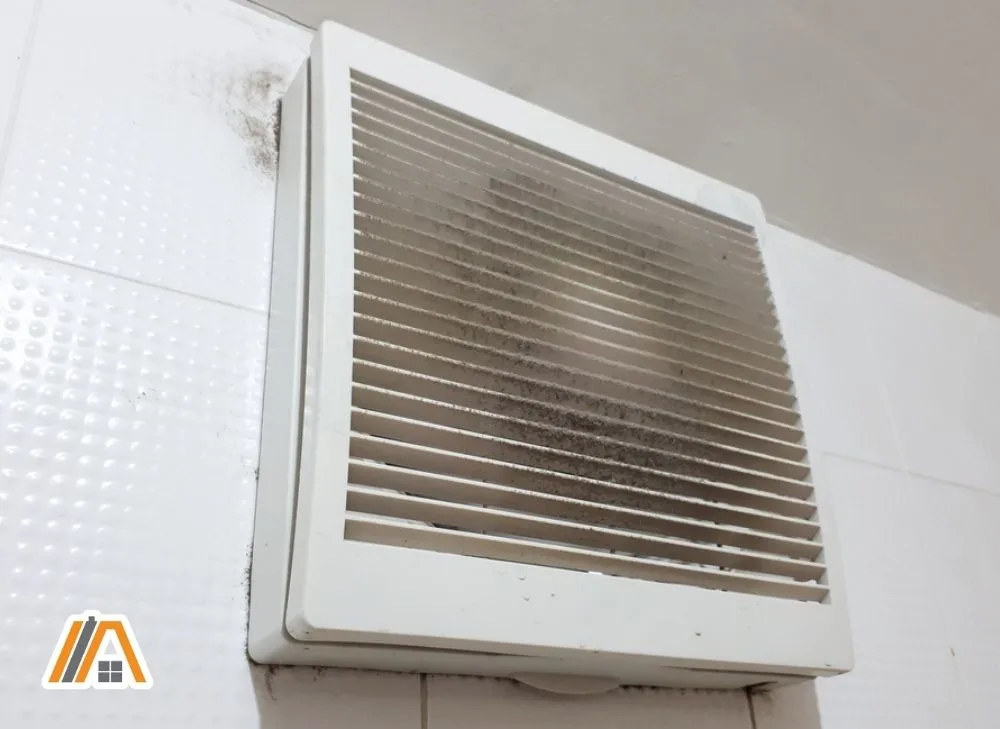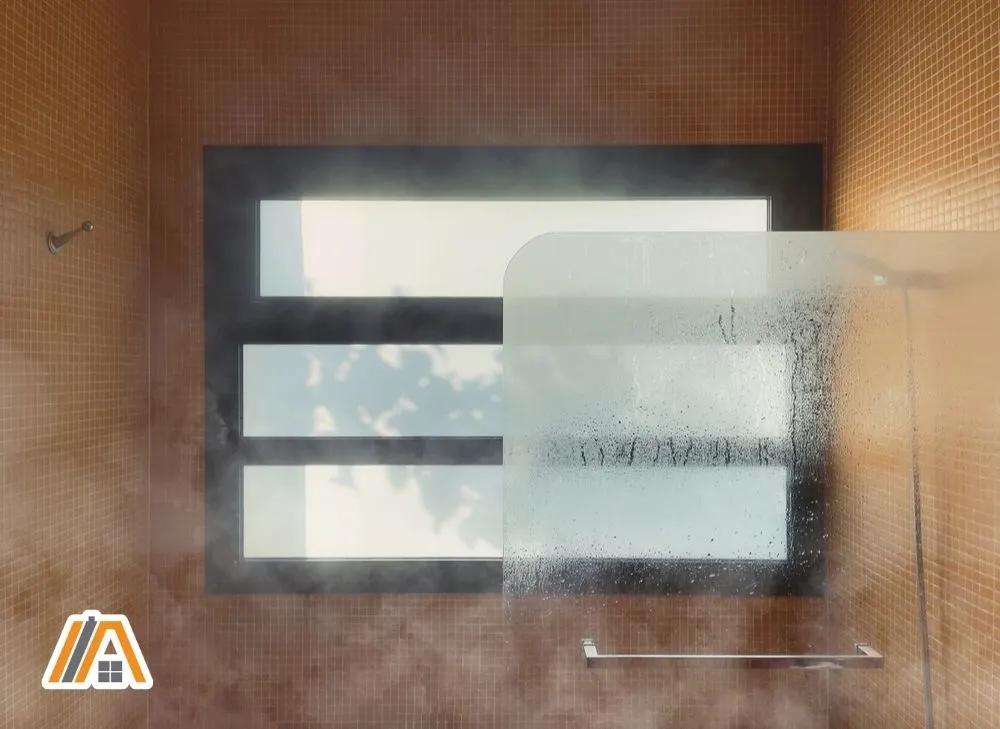Bathroom fans typically make a noise when they operate. They also use electricity, and they are not designed to run for long periods of time. This means that when your fan starts turning on by itself, what starts as an inconvenience can quickly become a pertinent problem.
Sometimes, you need a professional to fix the issue, and other times you just need to adjust the settings on the fan.

Humidity-sensing bathroom fans turn on by themselves. Sometimes, they’re set wrong or the sensor is damaged, so they come on at odd times. Normal fans can be defective (moisture damage, switch problems, wiring issues, and power fluctuations). Air cycle modes turn fans on and can also be faulty.
Your Fan Is Equipped With Humidity Sensor
The most likely reason behind your fan turning on by itself is that the exhaust fan is equipped with a humidity sensor.
The sensor decides when the fan needs to turn on and when it is OK to turn off based on humidity levels in the air.
Since you may not always be aware of the changes in air humidity, it will seem like the fan turns on and off by itself.
This method of operating is actually very beneficial and there are usually no issues with a “phantom fan” as the level of humidity at which the fan will come on is typically set quite high, i.e., at the levels encountered in a steam-filled bathroom.
However, the sensor can be set low enough that minor increases in atmospheric humidity can trigger the fan to turn on. Either you weren’t aware that it was too low or the level was altered accidentally by a child or durning cleaning/maintenance.
Try increasing the threshold humidity value on the fan. If this does not work, you may need to replace the unit.
How to Recognize a Humidity-Sensing Fan
If you weren’t paying close attention to your fan’s features or you inherited the bathroom fan with the house, then you will have to determine if you are dealing with a humidity sensing bathroom fan.
If you are not, then you will have to look for another possible reason.
Get hold of the manual for the bathroom fan if you can. This will tell you clearly if it is a humidity sensing model or not.
You can also look on the fan itself for a model/product number and Google this with the brand in order to locate an online version of the manual.
Otherwise, you can look for visual clues/confirmation.
Firstly, the humidity-controlled fan will likely have a switch that looks different to and/or is larger than your regular light switch.
If you have a humidity-controlled switch, you shouldn’t have any problems noticing it. The humidity-controlled switch will look different and be bigger than your regular light switch.
You will also likely see small vents on the switch control panel through which air flows to reach the sensor.
Secondly, you can look on the fan unit itself. This is what you will have to do if the fan is not controlled with a specialized switch.
Sometimes, the sensor is located in the box with the fan. =
In this scenario, you will have to open the exhaust fan by taking off its grill. If your fan is equipped with a humidity sensor, you will most likely find it in one of the corners once the cover is removed.
Can the Sensor Be Disabled?
Some exhaust fans provide you with an option to disable a humidity sensor completely and instead have the fan run on:
- manual operation
- regular timer
- air cycle mode, which operates on a repetitive (usually hourly) cycle with set time on and time off intervals.
The number of options you have will depend on the model you buy.
These settings can be accessed either by their own button on the humidity control switch panel or by removing the control panel’s cover (the face) and finding them underneath the humidity switch.
If you set your fan to manual, you should let it run for a sufficient amount of time after showering before turning it off to ensure that the moisture is removed from the air and won’t settle in the bathroom and cause issues.
If the exhaust fan doesn’t provide any of these three options, you probably won’t be able to bypass the sensor. This is because the fan units are wired differently.
In that case, the sensor can’t be disabled without disabling the fan itself, which is not recommended.
However, there is one way out of this situation, which brings us to the next point.
Alternative Option: Adjust the Settings
Adjusting the setting is a much better option than disabling the fan, although not all humidity-sensing fans come with an adjustable threshold level.
This is often the best solution when the weather is causing your fan to randomly turn on.
In some cases, the benefits of a humidity sensor could be replaced by issues if you live in an extraordinarily humid climate.
Suppose the air humidity in your area is naturally and significantly higher than average. In that case, the humidity sensor will keep the fan running at all times unless you change the preset humidity level to a higher percentage.
Sometimes, you will not be able to set it high enough because atmospheric humidity is high enough to be problematic in the house.
What I mean by this is the amount of moisture in the air naturally is what the industry considers damaging.
Fans are designed within the parameters of what is damaging, so you will not be able to set the fan to turn on only when the moisture levels are well above the level when damage can start to occur because this setting option does not exist.
Furthermore, humidity levels change with the seasons. If the humidistat was set during the wintertime when indoor air is relatively dry it will most likely be turning on way too often in the summer. This is why it’s a good idea to adjust the humidity setting twice a year.
Generally, all humidity sensors can have their turn-on point adjusted in order to tailor the fan to your climate and needs.

To do this, first, you should turn off the power at the breaker to safely gain full access to your humidity sensor.
Also, make sure that the bathroom humidity is at its normal levels (i.e., don’t try to do this right after showering).
As we mentioned before, the sensor can be located in a humidistat’s control panel on your wall or directly in the exhaust fan. Therefore, you will either have to take off the faceplate of the humidity control panel or remove the fan grill from the housing.
After you gain access to the sensor, you can adjust it by turning it to the value of air humidity percentage that you want to be your new turn-on point.
Different manufacturers and different fan models will offer a range of settings. Some sensors even allow you to adjust fans sensitivity or set a timer, and so each humidity sensor will look slightly different.
You can watch this video as a general guide to give you an idea of what to expect if the humidity sensor is inside the exhaust fan.
The next video shows how to adjust the humidistat’s control panel.
Your Humidity Sensor Is Broken
Humidity sensors on bathroom exhaust fans can malfunction due to some defect or normal wear and tear.
Additionally, the sensors can be damaged, which also causes them to malfunction.
When the sensor is not working properly, it can react at a humidity level below what it is supposedly set to or falsely detect certain levels of moisture in the air.
While your problem is a fan that turns on when it shouldn’t it’s helpful to know that a broken humidistat can also keep the fan running continuously or not turn the fan on at all.
When buying a humidity sensor fan, it is vital to opt for a reputable manufacturer and a reliable model. Most of the time, this equals a higher price point, but it is always worth it in the long run.
What Causes Humidistats to Malfunction?
Not all humidity sensors are created equal. Those of low quality are prone to malfunctioning, and most often don’t last longer than a year.
While the most likely causes of sensor malfunction are its low quality and cheap materials, there could be other triggers.
Some bathroom fans come with a pull cord—a manual override mechanism.

If this is accidentally pulled, then the humidistat is bypassed and the fan will turn on.
The sensor malfunction could be due to improper maintenance or advanced age (wear and tear). There is a two-fold effect here.
Firstly, both of these things can directly affect the functioning of the humidistat.
Secondly, they can also make the fan itself less effective, so the humidity levels in the bathroom remain higher and little is needed to get the moisture levels past the turn-on point.
Generally, it is also a good idea to check the wiring if the humidistat fails to turn the fan on or off in accordance with its settings.
What Are the Solutions?
- Only buy high-quality humidistats from reputable manufacturers.
- If there is a pull cord causing the fan to override, there is an easy fix. You need to switch the fan back to the sensor mode. Some exhaust fans have a neon light that indicates whether the cord was pulled. But many fans don’t have the light, and so you will have to check the cord position yourself.
- Keep your fan clean, ensure nothing is blocking the ducting or the outside of the fan (if the fan vents straight out). Keep in mind that even the best humidity sensors can deteriorate with age, and they will eventually need replacing.
- However, before you deem the humidistat faulty, make sure the problem is not with the motor or blades of the exhaust fan.
- If you suspect the source of your problems could be the wiring, it is best to call an experienced electrician to check if all the wires are wired correctly.
Air Cycle Mode Is Malfunctioning
I mentioned air cycle modes earlier as an alternative control option for a faulty humidistat in a humidity-sensing bathroom fan. However, the air cycle program itself can malfunction.
Using this feature, the fan can be set to, say, run for 20 minutes and shut off for 40 minutes each hour. If the wiring or programming starts to fail or glitch, then the fan can turn on when you aren’t expecting it to.
In addition, if you don’t know that this is the type of fan operating in the bathroom, then it will seem to turn on by itself, albeit following a very regular pattern!
Your Regular Bathroom Fan Is Faulty
If you don’t have a humidity sensor or a fan that is programmed to run continuously, but your fan seems to have a mind of its own regardless, these are the most common causes.
Blocked Vent
Proper maintenance is the key to a well-working exhaust fan. As you are most likely aware, a dirty fan could slow down or damage the motor. But another important step is to ensure that the venting channel (whether it leads through ducting or the fan vents directly to the outside) is not blocked by anything.

The fan could very quickly become blocked with fluff or other stuff, especially if it vents directly outside. That would cause the excess moisture to stay inside the fan and potentially mess with its electronics.
The only thing that can prevent or resolve this issue is a thorough clean-up.
Faulty Switch
A faulty switch can have a tenuous contact. In such cases, the on/off position of the switch may not be making a difference. Things like air temperature or vibrations can cause the contact to close and your fan will turn on by itself.
Faulty switches and improper wiring are two common issues that an experienced electrician can easily resolve.
Incorrect Wiring
If there is a problem with the wiring, you will probably hear the fan making noise when switched off.
Loose or improper connections can lead to the fan malfunctioning and turning on when it should not. You might have to replace or fix your wiring.
Again, the best thing to do is to leave this type of work to professional electricians. If you ever attempt to check the wires yourself, always turn the power off and use a voltage tester prior to any work.
Power Fluctuation
Some exhaust fans automatically turn themselves on after there is a power outage. This issue is not that common, but it is something to look into if you often experience power fluctuations in your house.
Do You Need a Bathroom Exhaust Fan?
Now, if your ghost fan is really bothering you, you can remove it or turn it off completely until it is mended or replaced, but remember that bathroom exhaust fans are essential to most bathrooms.

Showers and baths cause a lot of moisture in the form of steam that gathers all over the crevasses of your walls. Once this moisture accumulates and has nowhere to go, it will start causing severe issues in your bathroom.
Without bathroom fans, you can face one or more of the following:
- Peeling paint
- Loose wallpaper
- Mold growth
- Odor buildup
- Foggy mirrors
- Accumulation of cleaning fluid fumes
- Bacteria breeding
Sources
https://www.vent-axia.com/faq/why-wont-my-humidity-fan-stop-running
https://blog.leviton.com/tech-talk-humidity-sensor
https://www.houzz.com/discussions/2647346/my-bathroom-fan-light-timer-is-haunted-turns-on-by-itself


